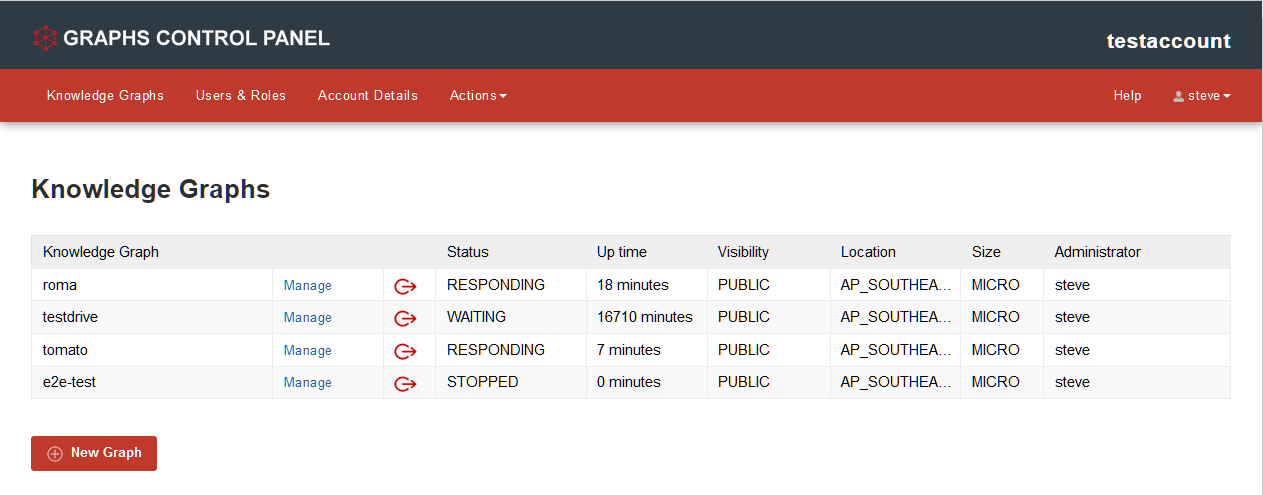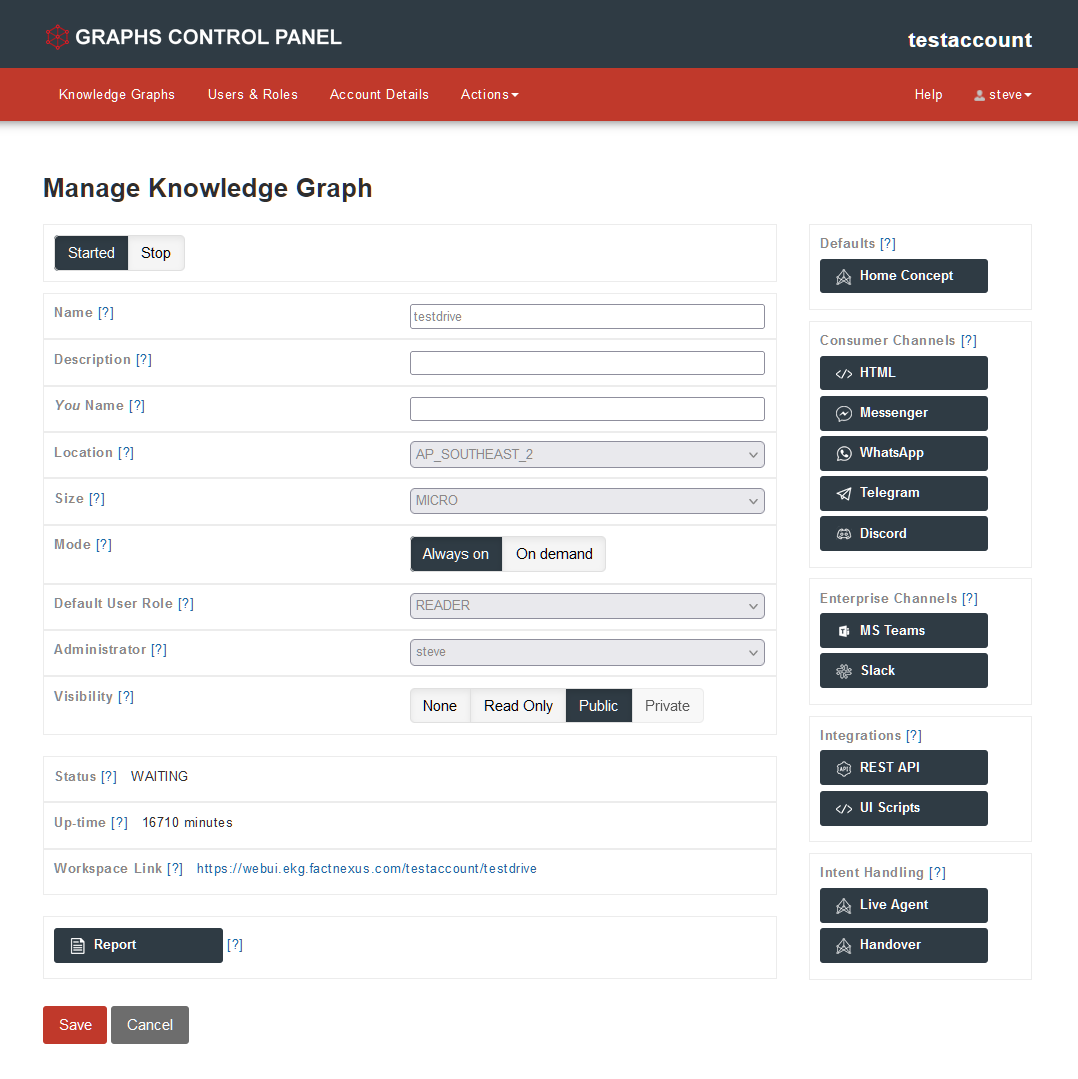Getting Started
A knowledge graph is structured representation of a knowledge Domain. That domain could be your company or project, its products and services, or a key subset of these.
You construct your knowledge graph by creating Concepts and connecting them to other Concepts. Those connections to other concepts are called Facts. A Concept is a discrete, self-contained piece of information and it shouldn't take more than a sentence or two to describe it.
Your aim is to create a concept that (together with its facts) will serve as an answer to every domain-related question a customer, team member or other user might ask.
You and your team will do this using Graph Workspace. Learn more about using Workspace at Workspace Help. Graph Workspace can be launched using the (->) button from your Knowledge Graphs panel or by using the Workspace Link from the graph's Manage Knowledge Graph page.
If you're new to knowledge graphs you might like to review this comprehensive step-by-step guide.
~

Your First Graph
Create your first graph using the New Graph button from the Knowledge Graphs tab. This will take you to a Knowledge Graph configuration page. From here you can specify and control every aspect and feature of your knowledge graph.
If you're unsure what a field or button is for, you'll find relevant help in the adjacent [?] tooltip.
Channel and other integration buttons are disabled until the graph has been named and saved. These will be available when you come back to Manage the graph
Remember to click the Start button to start working with your graph.
Managing Your Graphs
A few tips...
Actions Menu: These menu items perform actions relevant to the screen you're currently viewing. If you can't find where to (say) launch a snapshot or delete a graph - check the Actions Menu.
Saving your changes: Clicking a button in the Manage Knowledge Graph page will usually bring up a dialog window. Any changes you make in that Dialog window won't be saved unless you click Save at the bottom of your Manage Knowledge Graph page.
Change propagation: Be mindful that it can take up to a minute for your graph to reflect the changes made at this Graphs Control Panel
Home Concept
A graph's Home Concept is a "fake" concept that is used whenever no query has been made or no appropriate concept can be found to use as an answer.
It's often the first concept a Workspace user sees, so use it to introduce the user to your graph and to provide a few links to concepts that they might find useful.
The concepts must exist in the graph before they can be referenced by the Home Concept. Use Graph Workspace to create any new concepts you need.
Graph Backups and Snapshots
Use Create Snapshot from the Actions menu to regularly create a copy of your graph. You should create a snapshot before and after any significant changes are made to your graph. There are no other backups created for your work.
Be careful with naming - a snapshot will overwrite any prior copy with the same name.
~

Users and Their Roles
Create a User and assign Role privileges for each Knowledge Graph the user is to have access to. These are the roles...
SUPERUSER: Can make graph changes and comments using Graph Workspace and can make changes using the API.
EDITOR: Can make graph changes and comments using Graph Workspace.
CONTRIBUTOR: Can make comments using Graph Workspace.
READER: Can browse a graph and its comments using Graph Workspace.
BLOCKED: Cannot access Graph Workspace.
DEFAULT: User is given the default role that is set for the graph. i.e one of the five above.
These roles don't apply to beth.ai Channels. Users of published channels will receive beth.ai messages (answers) generated by your graph but will never see comments made by Contributors. Switch the channel Off to disable this access.
Additional access control is applied to Enterprise Channels (Slack and MS Teams). Only members of the teams you specify can ask questions and get answers from Beth.
beth.ai responses in Enterprise Channels also carry a link to the relevant concept in Graph Workspace. Roles are applied when they click that link.
Monthly Queries
A query is any question or comment from a user in any connected chat device or in any Consumer or Enterprise channel. A request made using Graph Workspace or the REST API is also a query. Query counts are collected from all graphs that have been run during the month and totaled.
You can view query counts and other metrics from each graph's Graph Instance Report. View this using the Report button on your Manage Knowledge Graph page.
What happens when you've used up your allocated queries for the month? A warning message will be sent to users first via Graph WorkSpace and then via the messaging channels. Graph instances will be stopped if your account's aggregated query count greatly exceeds what's been allocated.
Using the API
The REST API is available to Business and Enterprise plans.
Before using the API, review the FactNexus EKG REST API documentation. When you're ready, click the REST API button at the appropriate Manage Knowledge Graph page.
Collect the endpoint and API Key from the Rest Integration dialog window and switch the integration On. Your graph can now be accessed using the API.
Changing Your Plan and Payment Details
You can change your plan and payment details by clicking Change Plan in the Account Details tab.
When You Need More Help
Head over to the FactNexus & beth.ai Community . Ask your question there and one of our team will respond as soon as we can.
